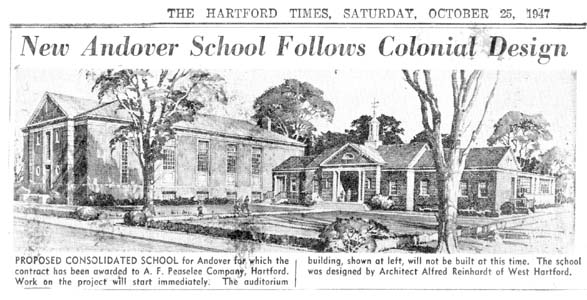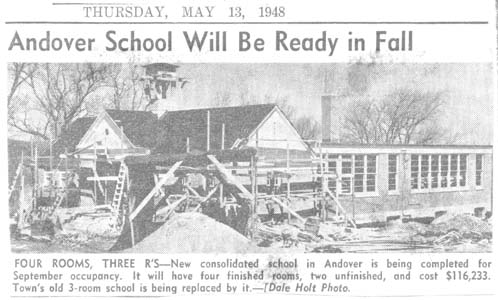
Andover, Connecticut |
Historical Information - Schools |
">
">
">
">
Schools By Scott Yeomans Copyright Scott Yeomans, 1998 From the beginning, it was the duty of the Ecclesiastical Society to oversee the education of the parish children. In January, 1747/8, shortly after its establishment, the Andover Ecclesiastical Society voted to keep a school. They appointed a school committee consisting of Obadiah Newcomb, Stephen Hutchinson, and Nathaniel Loomis. This school was to be supported by the "cuntry bounty and the premium of each town and by the parents of the children in school." The "cuntry bounty" being aid from the county roughly equivalent to today's state aid. The "premium of each town" was Coventry's, Hebron's and Lebanon's share of the cost of maintaining the schools in Andover Society. In both 1751 and 1755, Andover Society records show the school committee "receiving the money that falls to us by law to maintain a school." By 1769 the single parish school apparently had grown too small, for in that year the Ecclesiastical Society decided to set up four distinct school districts within its bounds. Each district would have its own one room schoolhouse, school committee, and school visitor. District #1 included all of Coventry on the west side of Hop river, including Abraham Burnap Jr. Its building was constructed on the Hartford-Norwich Turnpike, across the road from Daniel Burnap's Farm (near Burnap Brook Road). A one-room schoolhouse built in this district in 1848 is the only district school building still standing in town in any form today. District #2 consisted of all of Coventry on the eastside of Hop River, excluding Abraham Burnap Jr.'s. Its schoolhouse was on Long Hill Road not far from Talbot's. District #3 took all of the children living in Lebanon. This schoolhouse was on the North Side of the Hartford-Norwich Turnpike (now Merritt Valley Road), across from where Lake Road intersects with it. District #4 took all of those that lived in Hebron. This schoolhouse was on the west side of Townsend Road just south of Staddle Brook. The Ecclesiastical Society continued to have charge of the schools until 1795 when the Andover School Society was formed. This new entity purchased a record book which provides us with a good picture of the state of the schools in the 19th century. It shows the district schools flourishing in the early days. In 1820, the first year that enumerations were recorded, a combined total of 178 students were enrolled in the four districts. Shortly thereafter began a decline that left only 112 scholars enrolled in 1841 and less than 60 students when Andover became the first town in the State to consolidate its schools in 1888. Myron Yeomans, Henry Dorrance, and others had been espousing the wisdom of consolidation for many years before the town took action. In the Combined Report of the Selectmen, Treasurer, Auditors and School visitors of the Town of Andover for the Year Ending Sept. 30, 1886, Henry Dorrance included in his school visitor's report; "Consolidation - If we could, indeed, come to our senses enough to unite and consolidate all our schools in the town and establish a good graded school, it would at once elevate the standard of education in our midst, so that all might exclaim 'How foolish we have been' in so long adhering to the old system." The Town did finally vote for consolidation in 1888; 36 fore, 18 against. The consolidation plan called for the Conference House to be used for the upper grades (5 through 8) and the S.W. District schoolhouse to be used for the lower grades (1 through 4). This arrangement continued until the S.W. school house burned, at which time the lower grades were then schooled in Post's hall (this was an area in Post's store next to the RR Station in the center of town). Soon the towns school age population declined to the point that the Conference House could hold them all. The town paid the Ecclesiastical Society $20 per year for the use of this building. The rented Conference House remained Andover's sole public school building until 1903 when the town completed a two-room structure in Andover Center. An additional room was added in 1924. This school, with its outside privies, served Andover's youngsters until 1948 when a "modern" brick four-room school was opened (the oldest portion of the present school). The new school was raised at a cost of about $120,000. It was built on land donated to the Town by Percy Cook. A new road, School Road, was constructed to access the area. Four major improvements have been made to this building since it's opening: the first was to redesign the existing basement to allow for two additional classrooms and a library; the second was to build a wing to include four more classrooms, a principal's office, a health room and an all-purpose room; the next addition added more classrooms and a new library; lastly a gymnasium and music room were built on the west end of the third project. The public schools in Andover have always been for the primary grades. Early on they handled grades 1 through 8. Today our school has classes for grades kindergarden through 6. Prior to 1957, students that wished to continue beyond the primary grades traveled to the Windam High School in Willimantic. In 1957, the town, acting regionally with Hebron and Marlborough, completed a Junior-Senior High School complex on Wall Street in Hebron. This building was enlarged in 1970 to add additional gym space, a new Industrial Arts wing and a Library / Media center. In 1980 a new Junior High School was built next to the old school which continues to serve as the Senior High School. To Return to the Main History Menu |


Doris Chamberlain - Principal of Andover Elementary School 1942 - 1971 |